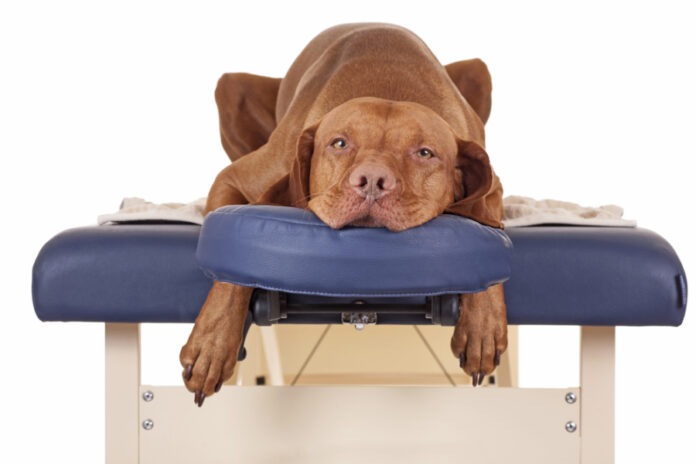The annual veterinary exam – what to expect

Your dog or cat should see the veterinarian at least once a year for a check-up. Let’s take a look at what an annual veterinary exam entails.
Regular check-ups are as important to our dogs and cats as they are to us. An annual veterinary exam establishes baseline testing when the animal is healthy, and allows for the early diagnosis of hidden diseases. While tests may vary depending on the veterinarian, this article outlines what our hospital includes in an annual veterinary exam.
1. Thorough physical examination and history
Doctors glean so much information about your dog or cat from simply talking with you and observing the animal. The physical examination involves checking not only the visible parts of your dog or cat, but also the internal parts by listening to the heart and lungs and feeling his abdomen and lymph nodes. It’s important not to overlook just how important both the discussion and physical exam are, so I encourage my clients to bring any and all questions to me during their annual visit. Also, it’s important to take note of any comments from the vet, since even “minor” issues discovered during the exam can develop into “major” problems if not addressed as soon as discovered.
For example, heart murmurs detected during the physical exam should be addressed by additional testing to determine if the murmur is a sign of heart disease (common but not life-threatening) or heart failure (which is fatal if ignored). Likewise, small lumps and bumps might represent cancer; early diagnosis and treatment may save your animal’s life and should not be ignored.
2. Vaccine titer testing
Titer testing, which typically costs under $100 in most cases, replaces annual vaccines for most infectious diseases in dogs and cats. We know that vaccines, given early in life, can induce immunity for many years. We don’t know the status of each individual’s immune system after vaccination, so titer testing is done to give us an accurate picture of his immunity to common diseases. Vaccines are given only if titer testing indicates a need, and if the animal is healthy enough to receive a booster immunization.
Titer testing personalizes vaccine recommendations for your dog or cat and reduces unnecessary vaccination, which can cause harm to both the animal and your pocketbook.
While titer testing is “routine” for holistic veterinarians, conventional vets may not understand it and might prefer to encourage vaccination (which is excessive most of the time). Some conventional doctors do titer testing if asked for, but may charge $300 to $400 (due to outside lab costs). Try to find a doctor who regularly does titer testing, to allow for an accurate interpretation of your dog or cat’s immunization needs, and lower costs.
3. Laboratory testing
 While a physical examination and history are important in uncovering potential health problems during the annual exam, lab testing is often ignored. However, running various lab tests is essential to giving us a look inside the body, diagnosing disease (despite the appearance of “health”), and establishing a baseline that is helpful for comparison whenever true illness occurs. Doing regular lab tests helps us uncover issues that evade a physical examination.
While a physical examination and history are important in uncovering potential health problems during the annual exam, lab testing is often ignored. However, running various lab tests is essential to giving us a look inside the body, diagnosing disease (despite the appearance of “health”), and establishing a baseline that is helpful for comparison whenever true illness occurs. Doing regular lab tests helps us uncover issues that evade a physical examination.
In my functional medicine practice, I run a variety of blood and urine tests that are specific to each patient. In general, I do a full blood profile (including thyroid testing when appropriate to age, breed, and condition), a full urinalysis, and a blood profile checking for inflammatory markers (TK, CRP) and vitamin D. In most of my “healthy” patients, one or more of these tests reveal abnormalities. These abnormalities can usually be quickly addressed, with health restored to the animal, thereby often avoiding further progression to serious and even life-threatening diseases. While blood testing does add to the expense of the visit, it is a critical part of your dog or cat’s annual check-up. Insurance may cover this testing; even if it’s not covered, it’s still less expensive to do this testing during the annual exam rather than wait for severe illness to occur, at which time costs climb a lot!
4. Parasite prevention
A conventional doctor typically prescribes heartworm preventive medication and chemicals for flea/tick control. I’m okay with the heartworm preventive since I don’t have a proven natural alternative; and since the medication in oral heartworm preventives only stays in the animal’s body for 48 to 72 hours, there is no risk of accumulating toxins that could cause problems for him.
However, I’m not okay with every dog or cat routinely taking flea and tick chemicals. In my practice, they’re not needed for most of my patients, who stay free of these pests thanks to lifestyle choices and to my prescriptions for diet and wellness supplements. Prescribing flea and tick preventive chemicals for every patient makes no sense, wastes precious financial resources on unnecessary medications, and exposes animals to needless chemicals that might act inappropriately and cause harm. Natural (or chemical when necessary) flea and tick control products can be used safely on an as-needed basis until the problems are adequately addressed.
Unlike heartworms, intestinal worms rarely cause ongoing issues in adult dogs and cats, although they are very common in puppies and kittens. Maximizing health through proper diet and supplements, as well as avoiding unnecessary vaccinations, goes a long way to preventing these worms. Regular de-wormings for puppies and kittens, using safe medications, kill GI parasites that can harm your young animal and infect human household members.
It’s important that your animal companion gets checked over by your veterinarian at least once a year (or even twice a year – see sidebar). An annual veterinary exam should be an integral part of your dog or cat’ health care regime, and will help keep him with you for many years to come.





